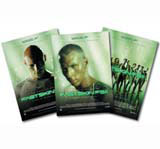Spectrum stretching

Designers now have a wide range of print processes at their disposal, using a kaleidoscope of colours and special effects. Lauretta Roberts looks at some of the latest trends and asks, why are they not taking off?
‘Do I want it in four colours? No! I want every colour.’ Almost every printer has an anecdote about a rookie designer that goes something along those lines. But, to be fair to those too green to know that there is no green in a standard ink set, there are far more ink options these days than just good old CMYK.
Extended ink sets, which usually comprise the standard four colours plus orange and green, are nothing new, but the tricky pre-press processes involved have impeded their widespread adoption. A few enterprising souls have stuck with it, however, and, with the most popular extended colour process – Pantone’s Hexachrome – currently celebrating its 10th anniversary, their persistence may well pay off, with a resurrection in interest and demand.
‘Hexachrome has been around for a while, but people tend to forget about it. It’s very fashionable within the greeting card sector, where we use it predominantly,’ says Jennifer Deacon, marketing manager of Milton Keynes-based print group Loudwater, which these days can have one of its presses running solely Hexachrome for up to a week at a time.
Pantone says that Hexachrome can achieve around 90 per cent of the spot colours found in its standard formula guide, which is estimated to be about twice that achievable through CMYK. On top of that, the addition of orange and green to a ‘purer’ CMYK set does lend the print more ‘pop’, hence its popularity with garish greeting card designs. But it’s also used successfully in other areas – for instance, the increased vibrancy of the print on Kellogg’s special edition Disney packaging is clear, even in reproduction.
An added benefit of the wider colour space is that expensive, specially made, spot inks (bespoke mixes of clients’ corporate colours) can, in some instances, be done away with. The downside, as previously mentioned is the pre-press process, since it requires a work flow that accommodates six colours, including immediate proofing devices and automatic colour separation tools. Plug-ins are available for Adobe Photoshop and Illustrator, under the brand name HexWare, while QuarkXPress and Adobe InDesign come readily Hexachrome-enabled, straight out of the box, and designing for Hexachrome is relatively straightforward.
You don’t have to stretch the ink set to achieve a broader spectrum of colours, however. There are some extended-gamut four-colour ink sets available, that achieve more colourful results by using brighter and/or more pigment in the make-up of the ink, though not all are available in the UK and some are still in the lab. Such colours are often referred to as Hi-Fi (or high fidelity) and, like Hexachrome, tend to swing in and out of vogue every few years.
Xsys Print Solutions’ Novaspace , which is claimed to have around 600 000 colour nuances, quite literally found itself at the forefront of fashion just after its launch in 2003, when it was used on the iconic April cover of Vogue, that featured Kate Moss in Ziggy Stardust mode.
It’s the magazine cover market where extended ink sets and special effect inks come into their own, lending titles valuable stand-out on the increasingly crowded news stands.
Emap, for instance, commissioned printer Greenshires to use the innovative new metallic ink process MetalFX – which has extended the metallic gamut to an enormous 104 million possibilities – to produce a striking cover for its January edition of Car magazine. This vastly increased metallic range has undoubted appeal for car manufacturers. Rolls Royce, for instance, produced its Phantom brochure (printed by Aldridge) using the process.
The basic premise of MetalFX is very simple – it involves a base silver colour (gold is coming soon), which is used in the first unit of the press, and then over-printed with standard CMYK inks. Printers have been doing this on an informal basis for years, but what MetalFX has done is take the trouble to create a swatch book and plug-ins for all the major software packages (including Photoshop, Illustrator and QuarkXPress), to specify and separate the output into individual plates. Technically, you can produce as many metallics as you like in one go, while only paying for one – the base silver.
Despite all this hard work and innovation, these processes still remain niche. Perhaps it’s because the colour possibilities have become so bewildering that most designers are happy to stick with CMYK. After all, in most cases, it does a perfectly adequate job. •
Lauretta Roberts is editor of PrintWeek
-
Post a comment




